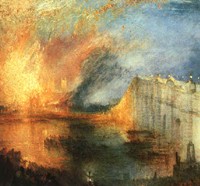JMW Turner
Biography of English Landscape Artist, Watercolour
Painter.
MAIN A-Z INDEX - A-Z of ARTISTS
|
JMW Turner |
 The Burning of the Houses of Lords and Commons (1835). One of Turner's most evocative landscape paintings, many of which are now world famous images of poster art. |
JMW Turner (1775-1851)Contents • Introduction
|
|
|
John Mallord William Turner, the leading light of English Landscape Painting, produced a large volume of watercolours, prints and oil paintings. His unique combination of Romanticism and down to earth realism had a significant influence on his contemporaries, including the French Barbizon School, and laid the foundation for the revolutionary landscape painting introduced by French Impressionism. Commonly known as the "Painter of Light", his most important works include Hannibal Crossing the Alps, (1812, Tate, London); Rain, Steam and Speed - The Great Western Railway, (1844, National Gallery, London), The Burning of the Houses of Lords and Commons, (1835, Philadelphia Museum of Art) and The Fighting Temeraire, (1838, National Gallery, London). He is rightly regarded as one of the best landscape artists in the history of European painting. |
|
COLOURS USED IN
PAINTING WORLD'S
GREATEST ART |
|
TOP PAINTERS IN
ENGLAND TOP AUCTION RECORDS |
Turner was born in London in 1775, the son of a barber and wig maker. His mother, who had been committed to a mental asylum, died when he was only 9 years old. His father taught him how to read, and outside of his study of art, that was the extent of his education. By the age of 13 he was selling his drawings through his father's shop window. When he was 14 he entered the London Royal Academy of Art School and was accepted into the Academy a year later (he was elected a full member at 27). (Note: for a comparison with a fellow landscape painter, see the short-lived Richard Parkes Bonington.) At the age of 15, one of his watercolours was accepted for exhibit at the Academy, a very rare honour for someone so young and unestablished. His early works consisted mainly of drawings and watercolours and it took him some time before he felt ready to tackle the medium of oil. In 1796 he exhibited his first oil painting at the Academy, Fishermen at Sea, and continued to exhibit nearly every year for the rest of his life. By the time he was 18, he already had his own studio on Harley Street. Within 2 years print makers were eagerly buying his drawings for reproduction. Turner's early success allowed him the financial freedom to innovate, which he did so over the years. Important early works include Hannibal Crossing the Alps and Ulysses Deriding Polyphemus, 1829 (National Gallery, London). |
|
THE ENGLISH SCHOOL |
He travelled extensively throughout Europe, including France, Switzerland and Italy, but it was in Venice that he found true inspiration, and he returned many times throughout his life. He created lots of watercolours and oil paintings of the city, including The Grand Canal, Venice, 1835 (The Metropolitan Museum of Art, New York). Natural catastrophes and phenomena fueled his imagination, he loved to paint ships, fires, violent seas, storms and fog. These subjects were covered in The Burning of the Houses of Lords and Commons, Peace: Burial at Sea, 1842 (Clore Gallery, London), Rain, Steam and Speed - The Great Western Railway and Slave Ship (Slavers Throwing Overboard the Dead and Dying, Typhoon Coming On), 1840 (Museum of Fine Arts, Boston). The theme of the destructive power of nature had first appeared in his painting Hannibal Crossing the Alps and continued throughout his career. He liked to experience events at first hand; when he heard about the fire at the House of Parliament, he rushed to the scene immediately. One rumour had it that he even had himself tied to the mast of a ship in order to experience the drama of a stormy sea up-close. |
 |
|
|
As his work matured, it became almost impressionistic in style, as he focused less on the details and more on the overall atmospheric effect. He became a master at rendering pure light by the use of shimmering colour. An example of this is the Great Western Railway painting where the train is barely recognisable. As far as Turner was concerned, his study of light was becoming paramount and he did not want objects in the painting to distract from this focus, preferring instead to concentrate on the play of light on clouds, water, skies and fires. His technique was being studied carefully by the Impressionists in France, in particular by Claude Monet. However, not everyone was pleased with his later work, one American buyer was said to be disappointed with the 'indistinctness' of his later paintings. Other important works by Turner include Staffa, Fingal's Cave, 1832 (Yale Center for British Art, New Haven), Norham Castle, Sunrise, c.1835 (Clore Gallery), Interior at Petworth, c.1837 (Tate Gallery, London), Moonlight, watercolour, 1840 (Tate), Sun Setting over a Lake, 1840 (Tate) and Landscape with Distant River and Bay, 1840 (Musee du Louvre, Paris). As he became older, he turned eccentric,
and except for his father, who lived with him for 30 years, he had no
close friends. He gave up meetings at the Royal Academy, and would not
let anyone watch him paint. He still held exhibitions but refused to sell
any of the paintings. When he was convinced to sell one, he was depressed
for days afterwards. His last exhibition was in 1850 at the Academy, after
which he went missing from his house. His housekeeper searched for him
for months, finally finding him at his mistress's house in Chelsea. He
had been ill for some time, and died the following day in December 1851.
He was 76 years old. As he took his last breath, he uttered the words
'the Sun is God'. He was buried in St Paul's Cathedral and lies next to
Sir Joshua Reynolds. |
|
|
The Landscape Art of JMW Turner One of the great Romantic
artists, Turner's earliest work is in water-colour in the manner of
the topographical draughtsmen. Even in the light of his later achievements
it is difficult to find signs of genius in these works of his youth. A
drawing such as the "Lambeth Palace" of 1790, his first exhibited
work, for example, is a competent and careful piece of architectural draughtsmanship,
and though it is promising enough for a boy of fifteen, there is in it
no hint of very exceptional powers. But during the last years of the eighteenth
century he was gradually coming to the front among the water-colour painters
and beginning to amass the prodigious knowledge of nature which bore fruit
in his later work. At this time he was working mainly for engravers and
making long tours on foot through England. Wales, and Scotland, making
pencil-sketches of ancient buildings, abbeys, castles, and the like which
he afterwards worked up into finished watercolours. By 1819, the date of his first visit to
Italy, he had already produced some of his finest pictures - "Calais
Pier", "Crossing the Brook", "Walton Bridges"
and "The Frosty Morning", are all masterpieces in their way
- and he had shaken off the heavy tone of his earlier work. As a water-colourist
he was without rival, and he could paint waves, skies, and distance as
no one had done before, but his study of light as an end in itself had
hardly yet begun. Beside this he studied with more accuracy
than had ever been done before the exact effect produced by light and
atmosphere upon colour. He noticed, for example, that shadows tend to
be of the complementary colour to their corresponding lights, instead
of being merely a darker shade of the same hue. In both of these ways,
in his system of tone and in his treatment of colour, Turner was a forerunner
of the French impressionists, and it was partly the sight of his pictures
in 1870 which led Claude Monet and Camille Pissarro to the development
of impressionist technique. Oils, watercolours and drawings by Turner hang in the best art museums across the world.
|
|
• For more biographies of great painters,
see Famous Painters. Visual
Artists, Greatest |